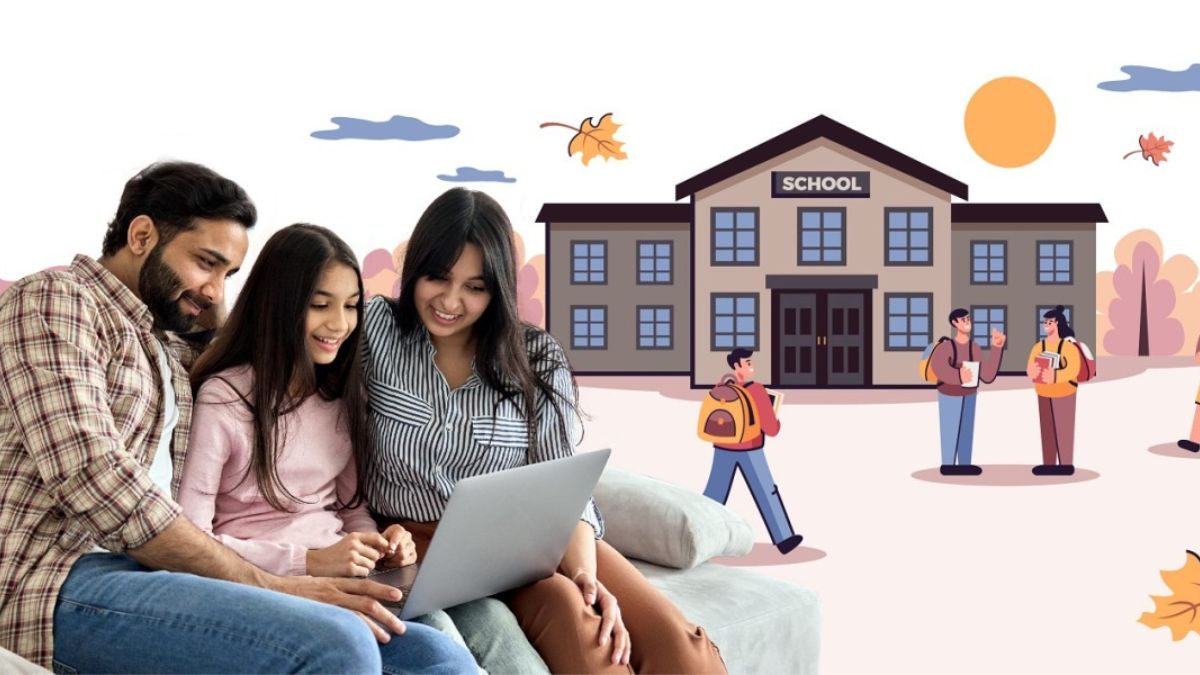EDUCATION
How to Choose a New School During the School Year: Tips for Parents

Choosing to switch schools mid-year can be a challenging decision for parents. This process often involves evaluating numerous factors to ensure the best fit for your child’s educational and emotional needs. This guide’s tips are designed to help parents navigate this significant change, with practical advice for each process step.
The decision to change schools is never easy, and factors such as social dynamics, emotional stability, and academic performance must all be considered. This comprehensive guide aims to equip parents with the knowledge to make the best decisions for their child’s future during this transitional period.
Why Consider Switching Schools Mid-Year?
Several compelling reasons exist for considering a school change during the academic year. A midyear school transfer might be prompted by various circumstances, making it essential to be well informed to facilitate a smoother transition. One of the most common triggers is the need to relocate due to job transfers or personal circumstances. However, this decision can significantly impact other considerations, such as ensuring a safer environment, addressing bullying issues, or aligning the school curriculum with a child’s academic needs. Therefore, parents must weigh these potential impacts carefully.
Assessing Your Child’s Needs
Understanding your child’s unique needs is crucial in transferring schools. This involves evaluating their academic inclinations, such as strengths and areas that require additional support. According to Education Week, children who change schools mid-year could face challenges adapting academically and socially, affecting their performance and personal growth. It also includes considering emotional and social aspects, like their comfort level in current peer groups or any anxiety surrounding school activities. Consulting with teachers or school counselors can provide valuable insights into these facets, helping to ensure that the new school environment will be conducive to your child’s growth. Frequent and open communication with your child also helps to identify any issues and work them out together as a team.
Researching Potential Schools
Comprehensive research is essential when selecting a new school. It’s important to evaluate various factors, such as the school’s academic programs, the accessibility of extracurricular activities, and the overall school culture, to ensure they meet your child’s needs. Tools like GreatSchools offer detailed reviews and ratings that can be instrumental in making an informed decision. These platforms allow parents to compare various schools based on academic performance, resources available, and community feedback. Visiting the potential schools in person is also advisable, allowing for direct interactions with teachers and staff for a firsthand perspective.
Involving Your Child in the Decision
Including your child in the decision-making process is vital to a successful transition. This involvement reduces anxiety and empowers them by giving them a voice in their educational journey. Engage in honest dialogues about their preferences and apprehensions. Discuss the pros and cons of each potential school together. This collaborative approach can help them feel more in control and informed, mitigating fears of the unknown and fostering a sense of readiness. By actively listening to their concerns, you can tailor your support to address specific worries, ensuring they feel heard and understood. Additionally, involving your child in decision-making can help them develop essential life skills such as critical thinking and decision-making, which are beneficial beyond their educational journey.
Preparing for the Transition
A smooth transition involves careful planning and communication with current and new schools. Key logistical tasks include ensuring that all necessary documentation—such as transfer certificates, academic records, and health forms—is in order. Consider organizing school visits and meetings with teachers and counselors before the transfer to ease the adjustment. Such introductions can give your child a sense of familiarity and ease on their first day. Additional steps like orientation sessions might offer further insights into daily routines and expectations at the new school. It’s also important to establish open communication channels with the latest school to ensure a seamless transfer of academic information and to address any specific needs your child may have. Furthermore, preparing a checklist of tasks to complete before the transition can help manage stress and ensure everything is taken care of on time.
Settling into a New School Environment
Transitioning to a new school involves more than just academic adaptation; it also requires social adjustment. Please encourage your child to seek clubs, teams, or interest groups that align with their passions. These activities promote personal growth and skill development and provide avenues for forming friendships. Creating a supportive social network can significantly enhance your child’s experience in a new environment, transforming potential loneliness into a sense of community and belonging. Encouraging your child to participate in school events and activities can also help them build connections with peers and teachers outside regular classes. Maintaining a positive attitude and celebrating small successes can help your child stay motivated and confident as they navigate their new environment.
Supporting Learning Beyond the Classroom
Beyond academics, extracurricular involvement is critical to a child’s holistic development. Please encourage your child to explore new activities and hobbies at their new school, which can foster a sense of enthusiasm and engagement. Consider options such as tutoring services, learning clubs, or study groups if they require academic support. Maintaining open communication with teachers to monitor progress and ensure that challenges are addressed promptly is also helpful.
Building a Support Network
Building a strong support network involves connecting with other parents, school staff, and faculty members. Being active in your child’s school community through volunteering or participating in events creates opportunities to form these connections. Establishing a rapport with teachers can inform you of your child’s progress and school happenings. A robust support network benefits your child’s educational experience and gives you trust and assurance in the new environment.
While navigating a midyear school transfer can be challenging, preparation and a comprehensive understanding of the process can lead to a positive and enriching experience. By following these steps, parents can facilitate their child’s smooth transition into a conducive educational environment where they can thrive.
EDUCATION
Children’s Injuries at Houston Daycares: Parental Rights and Legal Remedies

Caring for your child’s safety is your utmost priority. Daycares in Houston should provide a safe, nurturing environment for your child. Unfortunately, accidents can happen, leaving your child injured. It’s a parent’s nightmare, but understanding your rights helps you take action. If your child suffers an injury at a daycare, you have options. You deserve to know what steps you can take to seek justice and ensure accountability. A Houston personal injury lawyer for child injury cases offers guidance and support during this challenging time. You need clear, effective solutions to protect your child’s future. Understanding legal remedies empowers you to hold those responsible accountable. This blog explains how to navigate legal paths and ensures you feel confident about your child’s well-being. Remember, your child’s safety is non-negotiable, and you have the right to pursue justice when that safety is compromised.
Common Injuries in Daycares
Daycare injuries can range from minor cuts to severe trauma. Knowing what commonly occurs helps you identify potential risks. Understanding the frequency and types of injuries provides insight into preventive measures.
| Type of Injury | Common Causes |
| Bruises and Scrapes | Falls, playground accidents |
| Fractures | Climbing equipment, slips |
| Head Injuries | Falling objects, falls |
| Bites | Interaction with other children |
Your Rights as a Parent
When your child is injured, knowing your rights is critical. You have the right to obtain detailed reports from the daycare. Requesting medical records and injury reports ensures transparency. Understanding your rights helps you advocate for your child effectively.
Legal Remedies Available
Legal remedies provide a path to hold daycares accountable. In Texas, filing a personal injury claim for your child involves specific steps. Consult with a Houston personal injury lawyer to navigate these complexities.
- Document Everything: Keep detailed records of all incidents.
- Seek Medical Attention: Get a professional medical evaluation for your child immediately.
- Contact a Lawyer: Professional guidance ensures you understand all legal options.
The Importance of Immediate Action
Taking immediate action is essential. Delay can lead to loss of evidence or missed opportunities for resolution. Early intervention supports your claim and protects your child’s rights.
Steps to Protect Your Child’s Future
Protecting your child’s future involves more than just legal action. Ensuring they receive proper medical care and emotional support is crucial.
- Medical Care: Follow up on all medical advice.
- Emotional Support: Be attentive to emotional changes and seek counseling if needed.
- Education: Discuss safety measures with daycare providers to prevent future incidents.
Understanding the Role of Licensing and Regulations
Daycares are subject to regulations ensuring child safety. Understanding these helps you evaluate the adequacy of a daycare’s safety measures. Regulations often dictate staffing ratios, safety standards, and facility inspections.
According to the Texas Department of Family and Protective Services, daycares must meet specific guidelines to operate. If a daycare fails to comply, legal consequences can follow, supporting your case for negligence.
Preventive Measures for Parents
While accidents can’t always be prevented, taking proactive steps minimizes risks. Choose daycares with strong safety records and open communication policies.
- Research Daycares: Check reviews and safety records.
- Regular Communication: Stay informed about daily activities and incidents.
- Advocate for Safety: Involve yourself in safety discussions with daycare providers.
In conclusion, addressing daycare injuries involves knowing your rights and acting decisively. You have the tools to protect your child and ensure their safety. Recognizing and utilizing your legal options empowers you to advocate effectively for your child. Your involvement, knowledge, and prompt action safeguard your child’s future.
EDUCATION
A2Z Education: A Comprehensive Approach to Modern Learning

Education is transforming faster than ever before. Advancements in technology, shifts in societal priorities, and the demand for lifelong learning have created a new paradigm for how we understand and pursue knowledge. Enter A2Z Education, a holistic and flexible approach that empowers learners to excel in a dynamic world.
This blog will explore what makes A2Z Education different, how it adapts to modern challenges, and the key reasons why we believe it is the future of learning. If you’re an educator, learner, or a parent looking to keep pace with modern education, this is for you.
What Is A2Z Education?
A2Z Education is more than just a method; it’s a mindset. It embodies a comprehensive, personalized, and future-proof approach to learning that addresses the needs of students and educators alike. Unlike traditional systems, which often focus narrowly on academic achievement, A2Z Education embraces a broader spectrum of skills, technologies, and life experiences for holistic personal growth.
This model integrates key elements such as personalized learning plans, technological tools, social-emotional development, and community involvement to prepare students for success in the 21st century.
Why We Need a Modern Learning Approach
The challenges of traditional education systems are well documented. One-size-fits-all curricula fail to cater to learners’ unique needs, resulting in disengagement and gaps in understanding.
Adding to this are the rising demands of the global workforce, which increasingly values adaptability, creative problem solving, and soft skills like communication and emotional intelligence (EQ). Combined, these pressures highlight an urgent need for an approach like A2Z Education that is more inclusive, flexible, and forward-thinking.
The Core Issues with Traditional Education
- Lack of Individualization
Traditional systems often ignore individual differences in learning styles, speeds, and interests. This leaves some students struggling to keep up while others are bored and unchallenged.
- Reliance on Static Methods
Static, teacher-led lectures dominate classrooms, limiting opportunities for students to engage in collaborative, hands-on, or self-directed learning.
- Missing Life Skills
Key skills like emotional regulation, critical thinking, and even financial literacy are often left out of traditional education systems, leaving students unprepared for real-life challenges.
A2Z Education addresses these gaps by adopting a more proactive and inclusive framework.
Key Pillars of A2Z Education
The strength of A2Z Education lies in its multidimensional approach to learning. Let’s explore its foundational pillars.
1. Personalized Learning Experiences
Customization lies at the heart of A2Z Education. Learners differ widely in their interests, talents, and paces, and personalized learning tailors the experience accordingly.
For instance, students may pursue customized study plans that enable them to work on areas where they need development while accelerating in areas of strength. AI-driven tools like adaptive learning platforms can analyze performance and suggest activities tailored to individual needs.
- Example Benefit: A student struggling with fractions in mathematics could receive targeted exercises and real-time feedback, while another excelling in algebra could start exploring calculus concepts earlier.
2. Tech-Driven Education
Technology plays a pivotal role in modernizing learning. With A2Z Education, tools such as virtual reality (VR), gamified education platforms, and AI tutors transform how students engage with content.
- Example Use Case: VR simulations allow budding engineers to prototype designs safely or bring historical events to life in immersive 3D environments, making learning interactive and deeply engaging.
Additionally, online platforms are bridging gaps for remote learning, enabling access to quality education regardless of geography.
3. Development of Soft Skills
The world needs more than academics. A2Z Education promotes the development of essential life skills like communication, adaptability, critical thinking, and emotional intelligence (EQ).
For example, group projects or peer-based learning opportunities expose students to diverse perspectives, improving collaboration and interpersonal dynamics. Programs are also designed to tackle mental health and stress management, ensuring well-rounded development.
4. Cross-Disciplinary Learning
The traditional siloed approach to subjects is outdated. A2Z Education takes an interdisciplinary approach, encouraging students to connect fields of study like technology, the arts, and business.
For instance, a robotics course might integrate principles from physics, coding, and visual design, showing students how diverse skill sets come together in real-world problem-solving.
5. Community Integration
Learning extends beyond the classroom, and A2Z Education thrives on involving families, communities, and industry professionals. Mentorships, internships, and volunteering opportunities connect students to the world around them and give them practical insights and experiences early on.
The Impact of A2Z Education on Learners
The multifaceted A2Z model is not just theoretical; it achieves tangible results. Here’s what students and educators gain from adopting this modern approach to learning.
- More Engaged Learners
By tailoring lessons to personal interests and leveraging interactive technologies, students become more invested in their education.
- Prepared for the Future
A strong emphasis on technology, interdisciplinary thinking, and problem-solving equips students with skills that employers across industries demand.
- Improved Mental Well-being
Building emotional intelligence and embedding stress-reduction techniques into curricula ensures that learners build resilience alongside academic excellence.
- Lifelong Learning Habits
The adaptability and curiosity instilled in students under the A2Z model encourage them to continue learning beyond their formal education.
How Schools, Parents, and Students Can Get Started
Transitioning to the A2Z framework doesn’t have to be overwhelming. Small changes introduced strategically can build momentum toward a more personalized and effective learning approach over time.
Schools and Educators
- Adopt technology gradually by starting with simple e-learning platforms or gamified lessons.
- Offer professional development programs that train teachers to implement student-centered strategies.
Parents
- Encourage curiosity by supporting your child’s interests and extracurricular activities.
- Take an active role in celebrating project-based learning and practical problem solving.
Students
- Be proactive in exploring your passions, even outside of formal education settings.
- Experiment with digital tools to identify learning methods you enjoy most.
Moving Forward with A2Z Education
A2Z Education offers a framework to redefine success in learning. It empowers individuals to grow academically, socially, and emotionally while preparing them for challenges yet to come.
Whether you’re an educator looking to innovate in your classroom, a parent eager to support your child’s growth, or a learner ready to take control of your education, the A2Z model enables progress on every front.
Start small, but think big. Transform learning into an experience that’s not just effective, but also meaningful.
EDUCATION
How Online English Tutors Use Storytelling to Make Learning More Engaging

Learning English doesn’t have to mean boring grammar drills and endless vocabulary lists. Across America, students are discovering that stories make language learning come alive in ways textbooks never could. When tutors weave storytelling into their lessons, students engage more deeply, remember the material longer, and enjoy the learning process.
This article explores how virtual English instruction uses narrative techniques to transform the learning experience from mundane to memorable.
Throughout this article, you’ll discover the specific storytelling strategies that make online English lessons more effective, the science behind why narratives improve learning retention, and practical ways students benefit from story-based teaching approaches.
Whether you struggle with grammar concepts, need to expand your vocabulary, or simply want more engaging English instruction, understanding how storytelling transforms the virtual classroom will help you recognize effective teaching when you see it.
Why Stories Make Learning Stick
Stories activate multiple brain regions at the same time, creating stronger connections in your brain than just learning facts. When information is wrapped up in a story, students process it emotionally as well as logically, which makes the memory stronger. This is why students often remember stories long after they forget the rules or definitions they were taught.
Besides helping memory, stories turn abstract ideas into real, relatable situations and characters. Grammar rules turn into tools for communication when they are shown through stories that students care about. This helps bridge the gap between knowing something in theory and using it in real-life conversations.
How Virtual Tutors Incorporate Storytelling
Online learning settings create new conditions that enable teachers to implement narrative-based educational approaches. Interactive storytelling becomes possible through screen sharing features which let students develop stories alongside their instructor instead of only receiving information.
When learning takes place through collaborative work students achieve higher participation levels alongside greater responsibility in their academic tasks.
Multiple teaching professionals have identified narrative’s ability to aid students in learning languages. Online English tutors, make use of storytelling methods to convert information into personal educational experiences. Faculty members use character building alongside plot creation combined with story evaluation which enables students to retain language patterns that translate into authentic communication.
Personalized Narrative Approaches
Real classrooms provide insufficient opportunities to deliver individualized story content that suits students’ personal preferences and their learning approaches. Virtual tutoring addresses this restriction through personalized story selection which lets students choose between science fiction stories, sports tales, and historical books. The individualized content engages students right from the start which drives their attention during entire lessons.
Different students interact with distinct storytelling structures because their learning capabilities and preferred strengths vary. Different students demonstrate better understanding through visual illustrations with animations or they excel when presented with audio content or interactive text-based programs. Online tutors follow a strategy to adapt their storytelling methods according to the personal learning preferences of their students to achieve better teaching outcomes.
Digital Storytelling Tools
The virtual learning space provides technological assets that outperform traditional education environments regarding the delivery of narrative instruction. The tandem implementation of interactive storyboards with digital character creators along with animated scenarios enhances visual retention by supporting vocabulary and grammar teachings simultaneously. The mixed media components produce interactive learning modes that enhance the student’s ability to remember information.
The virtual education environment enables instructors to use genuine cultural materials that let students learn through worldwide storytelling approaches. Educational activities based on different kinds of stories let students master linguistic skills concurrently with cultural understanding. Language proficiency achieves higher levels of development when culture learns through storytelling rather than learning grammar alone.
Benefits of Different Learning Challenges
Storytelling helps students overcome several challenges in learning English:
- Grammar confusion: Stories show grammar rules in real, understandable ways.
- Vocabulary limitations: Character dialogue helps students remember new words.
- Reading comprehension struggles: Plot-driven stories keep students engaged and improve their understanding.
Overcoming Grammar Anxiety
Many students get anxious about grammar rules because they seem disconnected from real conversations. Story-based instruction helps students see how grammar works in a story. For example, verb tenses are easier to understand when they show how time passes in a story, making grammar feel less like a set of random rules.
Mistakes also stop feeling like failures. When students make mistakes with grammar in a story, it feels like fixing part of the story rather than messing up. This makes students feel less anxious and more motivated to fix their mistakes, which helps create a more positive learning environment.
Expanding Vocabulary Naturally
Memorizing word lists might help in the short term, but it’s hard to use those words in real conversations. Story-based learning introduces new words in context, which makes it easier to remember them. When students hear new words in a story, they can understand them better because the words are connected to the characters and situations in the story.
The more students hear and see certain words in different parts of the story, the more they remember them. The emotional connection to the story also makes the vocabulary stick better than using flashcards or memorization.
Comparing Traditional vs. Narrative-Based Tutoring
| Learning Element | Traditional Approach | Storytelling Approach |
| Grammar Instruction | Isolated rules and exercises | Rules are shown through character dialogue |
| Vocabulary Development | Word lists and definitions | Words introduced through plot needs |
| Student Engagement | Primarily cognitive focus | Emotional and cognitive involvement |
| Error Correction | Direct correction of mistakes | Revision as part of story improvement |
| Cultural Context | Separate cultural notes | Integrated through authentic narratives |
| Retention | Short-term memorization | Long-term conceptual understanding |
Measuring Progress Through Story Development
Traditional tests don’t always show how much a student is learning. Story-based teaching, however, lets students create their own stories to show what they’ve learned. As students write more complex stories, they show how well they understand and use the language. This kind of progress is more visible and concrete than just test scores.
Parents and students can track their improvement by looking at story portfolios. These collections of stories show how a student’s language skills have grown over time, from simple stories to more complex ones with rich plots and characters. This progress helps motivate students and boosts their confidence in using English.
Implementing Storytelling in Different Age Groups
Different age groups need different kinds of stories. Young kids like stories with clear plots and simple characters, while teens are more interested in stories that deal with social issues and more complex themes. Online tutors can adjust the stories based on the student’s age and language level to keep them engaged and learning.
As students become more proficient, the stories they work with also become more complex. Beginners might focus on simple stories with basic vocabulary, while more advanced students might explore narratives with deeper themes and figurative language. This helps students stay challenged without being overwhelmed.
Frequently Asked Questions
How does storytelling-based tutoring help students prepare for standardized tests? Although storytelling might seem different from the usual test preparation, the deeper understanding of language gained through stories helps students perform better on grammar, vocabulary, and reading comprehension sections of tests.
Can storytelling approaches help students who primarily need academic writing support?
Yes! Storytelling helps students understand structure, organization, and voice, all of which are important for academic writing. These skills transfer directly to writing more powerful essays and reports.
Do storytelling methods work for students who consider themselves “not creative”?
Absolutely. Online tutors guide students through storytelling step-by-step, so they don’t need to be naturally creative. The method builds confidence and creativity gradually, making it suitable for all kinds of learners.
Conclusion
Online English tutoring through storytelling represents a big change from just memorizing rules to using language to communicate. By learning grammar, vocabulary, and reading comprehension through stories, students understand language more deeply and actually enjoy using it. This story-based approach makes learning feel less like a chore and more like an adventure.
For students who have struggled with traditional English lessons, online tutoring that uses storytelling offers a fun and effective alternative. It helps students engage with the language in a meaningful way, making communication easier and more enjoyable.
-

 BLOG1 year ago
BLOG1 year agoATFBooru: A Hub for Animated Art and Community
-

 CONSTRUCTION1 year ago
CONSTRUCTION1 year agoBuilding a Home Gym in Your Basement (7 Key Renovation Tips)
-

 BLOG1 year ago
BLOG1 year agoFictionmania: A Deep Dive into the World of Transformative Stories
-

 GAMES1 year ago
GAMES1 year agoSnow Rider 3D: Unblocked Tips and Tricks for Gamers
-

 LIFESTYLE1 year ago
LIFESTYLE1 year agoVersatile Living: Stylish Indoor Outdoor Rugs with Eco-Friendly Appeal
-

 BLOG1 year ago
BLOG1 year agoGIFHQ: A Comprehensive Guide
-

 BLOG1 year ago
BLOG1 year agoVincent herbert new wife: A Detailed Overview
-

 LIFESTYLE1 year ago
LIFESTYLE1 year agoAchieve Elegance with Chic Blue Formal Dresses and Redken Professional Hair Care for All Hair Types
